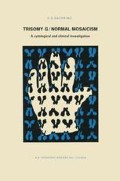Abstract
Lejeune et al. (1959) first described the presence of an extra G chromosome in Down’s syndrome patients. Up to now, it has not been possible to distinguish with certainty between chromosomes 21 and 22. In the case of patients with clinical Down’s syndrome the chromosome is usually numbered 21. A number of patients have been described with an extra G chromosome without the clinical stigmata of Down’s syndrome, in which cases it has been suggested that this might be a chromosome 22. A review of these patients has been given by Chaudhuri et al. (1968).
Access this chapter
Tax calculation will be finalised at checkout
Purchases are for personal use only
Preview
Unable to display preview. Download preview PDF.
Rights and permissions
Copyright information
© 1971 Springer Science+Business Media Dordrecht
About this chapter
Cite this chapter
Sachs, E.S. (1971). The Literature. In: Trisomy G/Normal Mosaicism. Springer, Dordrecht. https://doi.org/10.1007/978-94-010-2956-8_2
Download citation
DOI: https://doi.org/10.1007/978-94-010-2956-8_2
Publisher Name: Springer, Dordrecht
Print ISBN: 978-90-207-0311-5
Online ISBN: 978-94-010-2956-8
eBook Packages: Springer Book Archive

